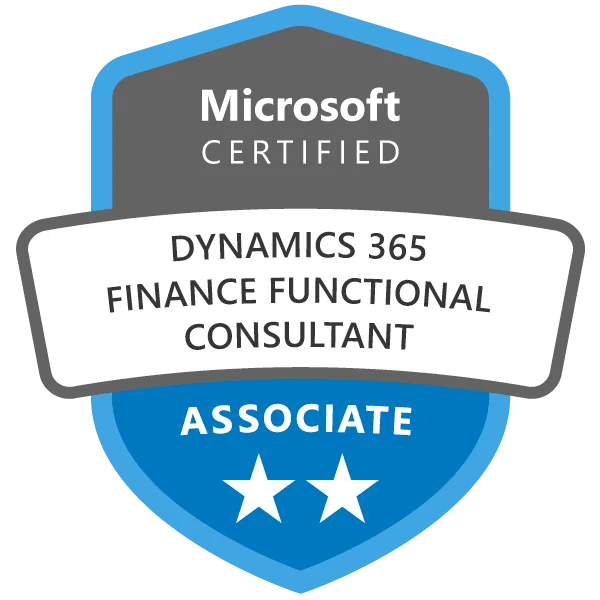Get new IT skills, get certified and lift your IT career to new heights without breaking the bank!
Unlimited Training - IT Courses and Certifications made simple and insanely affordable. Get access to 60+ LIVE instructor-led Courses for the price of less than one course.











course: Microsoft Certified: Dynamics 365 Finance Functional Consultant Associate (MB-310)
Duration: 5 days
Format: Virtual or Classroom


Overview
Master Dynamics 365 Finance functionality with our comprehensive course. Learn to configure and customize Dynamics 365 Finance to meet business requirements. From financial management to reporting, this course covers all aspects of Finance Functional Consultant responsibilities. With hands-on labs and expert-led instruction, you'll gain the skills needed to pass the MB-310 exam and become certified as a Dynamics 365 Finance Functional Consultant Associate. Enroll now to get certified and excel in financial management with Dynamics 365.
 Instructor-led training
Instructor-led training Practice test
Practice test Pre-reading
Pre-reading Personal Learning Path
Personal Learning Path Certification Guarantee
Certification Guarantee Email, chat and phone support
Email, chat and phone support









Who is this course for?
The Microsoft Certified: Dynamics 365 Finance Functional Consultant Associate (MB-310) certification is designed for professionals who implement and use Dynamics 365 Finance. The certification is ideal for individuals who have experience in implementing Dynamics 365 Finance solutions and want to validate their skills and knowledge in this area. The MB-310 exam covers various topics related to Dynamics 365 Finance, such as configuring and managing financial modules, managing budgeting and accounting processes, and managing financial data migration. The exam also covers topics related to implementing and managing Dynamics 365 Finance workflows and integrations with other applications and services.
Curriculum
Preparation
At Readynez, we provide many resources and have experienced experts in the field. That is why we are also very successful with many satisfied customers. You can therefore safely take your course with us. In order to take the MB-310 training, however, some prerequisites are required.
You'll have the perfect starting point for your training with these prerequisites:
Meet some of the Readynez Instructors you can meet on your course. They are experts, passionate about what they do, and dedicated to give back to their industry, their field, and those who want to learn, explore, and advance in their careers.

Agne is a devoted Dynamics 365 F&O senior consultant with more than 13 years of experience in the ERP Business with Microsoft Dynamics.
She has been involved with Dynamics 365 F&O consulting services in Finances, Trade, Inventory and other areas for many years and has extensive experience with design of AX extensions for different integrations and business requirements.
She has worked for the leading Microsoft Dynamics partners in Baltics and been in charge of high-volume Microsoft Dynamics 365 F&O solutions' implementation projects as an analytic, senior consultant and project manager.
Over 300 specialists from Microsoft Dynamics Partners' companies worldwide have participated in Dynamics 365 F&O Application workshops led by her during her career as an instructor.

Kat Weber is a Power Platform and Dynamics (CE and F&O) Consultant with 15+ years’ experience in ERP and CRM.
Kat Weber is a Power Platform and Dynamics (CE and F&O) Consultant. She has 15+ years’ experience in ERP and CRM project implementation and 10+ years Dynamics experience as a Business Analyst, Implementation Consultant, and Trainer delivering projects/training in English, German, and Spanish.
Kat has worked as a consultant with implementation partners and end users. Her industry experience includes housing, pharmaceuticals, metallurgy and IoT to name just a few.
FAQ
The Microsoft Certified: Dynamics 365 Finance Functional Consultant Associate (MB-310) consultant is a certified professional who has passed the MB-310 certification exam demonstrating their knowledge and skills in implementing and configuring Dynamics 365 Finance solutions for businesses. They work closely with other consultants, project managers, and business stakeholders to ensure that the Dynamics 365 Finance solution meets the client's needs and that their certification validates their expertise in managing financial processes in Dynamics 365 Finance.
The Microsoft Dynamics 365 Finance Functional Consultant Associate Certification exam is known to have around 40-60 questions, but this may vary over time. It is best to check the official Microsoft certification website or contact Microsoft support for the most accurate and up-to-date information regarding the MB-310 exam.
The cost of the MB-310 exam is €165 per attempt, but this may be subject to change over time. Additionally, the exam fees may vary by location and currency. It is recommended to check the official Microsoft certification website for the most accurate and up-to-date information regarding the MB-310 exam fees.
The passing score for the MB-310 exam is 700 out of 1000. However, it is important to note that Microsoft may update the exam passing score at any time. It is recommended to check the official Microsoft certification website for the most accurate and up-to-date information regarding the passing score for the MB-310 exam.
The MB-310 exam has a time limit of 180 minutes or three hours.
The MB-310 certification does not have a set expiration date. However, Microsoft may update its certification policies at any time, so it is recommended to check the official Microsoft certification website for the most accurate and up-to-date information on certification validity.
To take the MB-310 certification exam, Microsoft recommends that candidates have experience in implementing and configuring Dynamics 365 Finance solutions, as well as a general understanding of financial principles and processes. However, there are no formal prerequisites for taking the MB-310 exam. It is recommended that candidates review the exam objectives and ensure they have a solid understanding of the topics covered before taking the exam.
While it is not strictly required to have previous experience to take the MB-310 certification exam, Microsoft recommends that candidates have experience in implementing and configuring Dynamics 365 Finance solutions, as well as a general understanding of financial principles and processes. Having prior experience though can be very helpful in understanding the concepts and applying them in real-world scenarios. However, candidates can still prepare for and pass the exam with thorough study and practice even without prior experience.
The difficulty level of the MB-310 exam may vary depending on an individual's level of experience and knowledge of Dynamics 365 Finance. However, it is generally considered to be a challenging exam that requires a deep understanding of the application and its functionality. To pass the exam, one must have a solid grasp of finance-related concepts and skills, as well as the ability to implement and configure solutions in Dynamics 365 Finance. Adequate preparation through studying and hands-on practice can increase the chances of passing the exam.
The amount of time it takes to prepare for the MB-310 exam varies depending on an individual's prior experience and knowledge of Dynamics 365 Finance. Some people may need several months of study and practice, while others may require only a few weeks. Microsoft recommends that candidates have at least one to two years of experience in Dynamics 365 Finance before taking the exam, so if someone has extensive experience in this area, they may require less time to prepare. It is important to create a study plan, review the exam objectives, and use resources such as Microsoft official training materials and practice exams to ensure adequate preparation.
The salary of a Microsoft Certified Dynamics 365 Finance Functional Consultant Associate (MB-310) can vary depending on factors such as location, years of experience, and job responsibilities. According to Payscale, the average salary for a Dynamics 365 consultant in the United States is around $92,000 per year. However, salaries can range from around $66,000 to $131,000 per year. It's important to note that this data is not specific to MB-310 certified professionals and may include other Dynamics 365 certifications as well.
If you are interested in pursuing a career in Microsoft Dynamics 365 Finance and Operations, this certification can be a valuable addition to your resume. It demonstrates that you have the skills and knowledge required to implement and configure Dynamics 365 Finance and Operations, and can be useful in securing a job or advancing your career in this field.
The MB-310 exam for Microsoft Certified: Dynamics 365 Finance Functional Consultant Associate is conducted by Pearson VUE through computer-based testing. The exam has 40-60 multiple-choice questions and a 120-minute time limit. Candidates can take the exam at a Pearson VUE testing center or through online proctoring. To prepare for the exam, candidates can use Microsoft's official study materials, such as Microsoft Learn or Microsoft Docs, or third-party resources, such as books, online courses, and practice tests. Passing the MB-310 exam earns the candidate the Microsoft Certified: Dynamics 365 Finance Functional Consultant Associate certification.
To prepare for the MB-310 certification exam, you should start by familiarizing yourself with the exam objectives provided by Microsoft. Microsoft's official study materials, such as Microsoft Learn and Microsoft Docs, provide comprehensive coverage of the exam topics and include hands-on exercises and simulations to help you gain practical experience. You can also supplement your preparation with third-party resources, including books, online courses, and practice tests. Joining a study group or community can help you stay motivated and gain a deeper understanding of the exam topics. Finally, practice is key to exam success, so take advantage of hands-on exercises and simulations, as well as practice tests, to identify areas where you need to improve.
Readynez is a training provider that can help individuals clear the MB-310 exam and become a Microsoft Certified: Dynamics 365 Finance Functional Consultant Associate. They offer a variety of training courses and resources, including in-person and online courses, practice tests, and study materials. Readynez's experienced instructors provide personalized guidance and support to help students fully understand the exam objectives and topics. Additionally, they offer a "Readynez Exam Guarantee" program that provides students with a free retake if they do not pass the exam on their first attempt. By taking advantage of Readynez's training and resources, individuals can increase their chances of passing the MB-310 exam and earning the Microsoft Certified: Dynamics 365 Finance Functional Consultant Associate certification.
With a Microsoft Certified: Dynamics 365 Finance Functional Consultant Associate certification, you can pursue various job roles related to Dynamics 365 Finance and Operations. Some of the job titles that you can consider include:
The Virtual Classroom is an online room, where you will join your instructor and fellow classmates in real time. Everything happens live and you can interact freely, discuss, ask questions, and watch your instructor present on a whiteboard, discuss the courseware and slides, work with labs, and review.
Our MB-310 Training is a 5-day Microsoft Dynamics 365 Functional Consultant Training.
Yes, our Microsoft Dynamics 365 Functional Consultant Training is available to attend virtually.
Reviews

Was very well structured course with a great trainer who really knew his topic well. Definitely feel prepared for the test after this.

The instructor took it from just powerpoints to live training, showing examples and case-studies, which is much appriciated. And as always the customer experience team helps out with any questions and customizations that delagates require!
Why Pay More??
Why settle for just one certification course when you can attend ALL certification courses for the price of less than one single course?

A perfect tool to help us develop the skills and competencies we need for success
 Kasper Meyer Christensen
Kasper Meyer Christensen
Businesses leveraging Readynez Unlimited save at least 50% on their training and certifications - and many up to 80%
Unlimited license holders attend on average 2.4 courses per year

For the price of less than one course.

Just cheaper and more flexible.

The easiest, most flexible and cheapest way to get Certified.

Attend as many courses you want - no limitations!

Refund provided if license costs surpass the value of your training.

Interact 1-on-1 with 50+ seasoned instructors.

